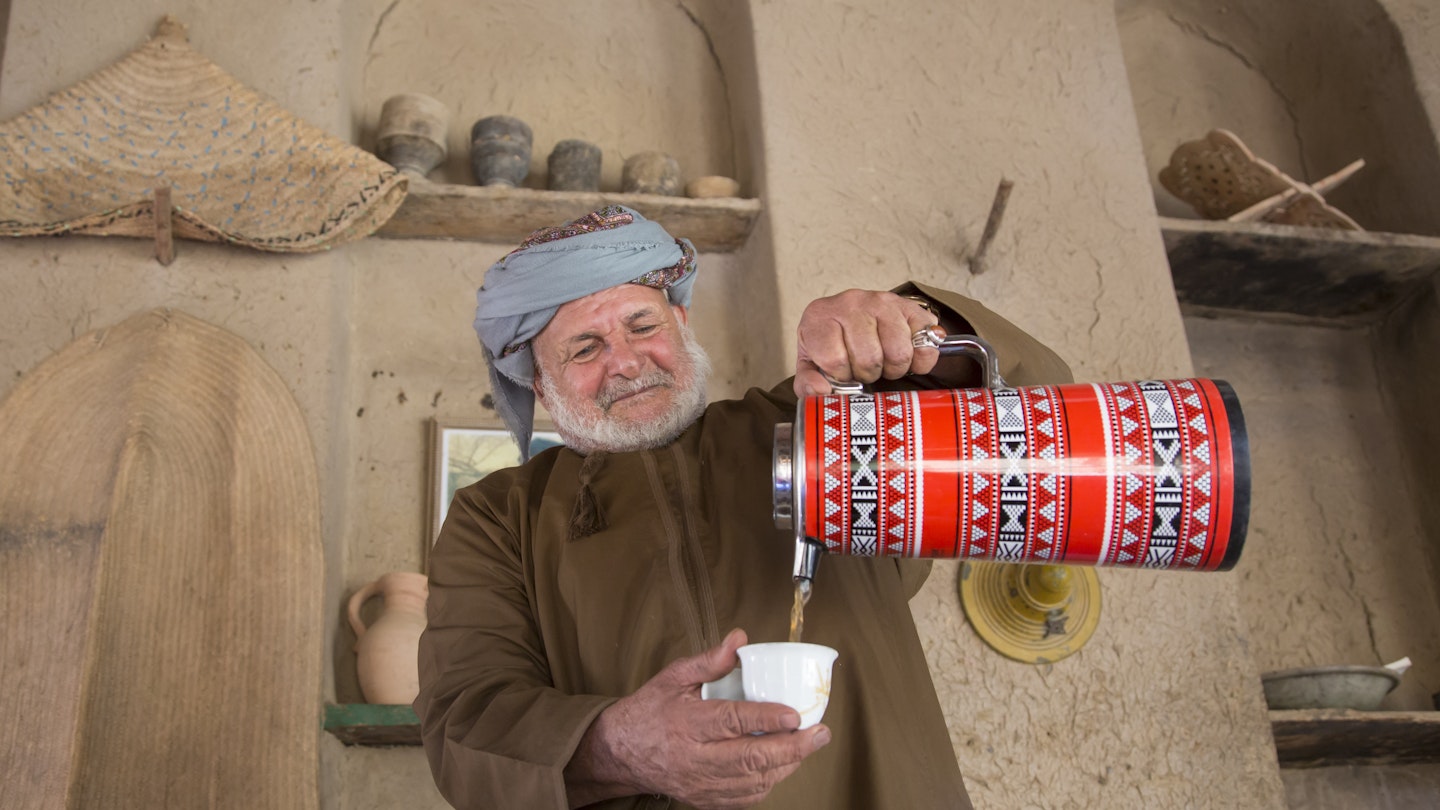Oman’s vibrant cultural heritage is deeply intertwined with the gifts of its terrain, permeating every travel experience here.
The country’s stories are found everywhere you go, from the atmospheric lanes of Mutrah Souq in Muscat, where ornate khanjars (traditional daggers) and patterned kumma (headpiece worn by Omani men) showcase excellent craftsmanship and pride, to the cliffside villages of Jebel Akhdar, where old men in sandals expertly navigate narrow farm trails and distill rose water in silver bowls. Every encounter in Oman evokes a strong sense of the land.
Few visitors realize that the history of the Sultanate of Oman dates back 10,000 years. Archeological finds and relics from the Neolithic period point to the presence of ancient settlements involved in the frankincense trade.
In the 17th century, Omani control of maritime routes and ports extended from the coasts of Persia (present-day Iran) to East Africa. Today, the country is known for its reverence for natural landscapes and its perfect balance of tradition and modernity.
Best Places to Visit in Oman
1. Muscat
Marvel at the effortlessly charming capital
In Muscat, stone forts with watchtowers and mansions with latticed balconies stand alongside low-rise buildings and contemporary architectural masterpieces, fitting together effortlessly. The capital of Oman has much to see, including charming museums in restored old houses, courtyard restaurants, and swanky shopping malls. The Sultan Qaboos Grand Mosque, with its arched walkways, colorful mosaic tiles, ornate dome, and Swarovski-crystal-studded chandelier, is an impressive example of modern Islamic architecture.
Admire whitewashed houses and blue-domed mosques along the 3km (1.9-mile) seafront promenade at Mutrah Corniche. Stroll toward Mutrah Fish Market for a closer look at the calligraphy-inspired slatted canopy roof and step inside to see the catch of the day. At Mutrah Souq, one of the oldest markets in the Arab world, you’ll find shops selling frankincense, lamps, local attire, pashminas, oud (perfume made from agarwood), and handmade sandals.
2. Bahla
Home to the legendary fort and pottery
The fortified oasis town of Bahla, rich in local legends and myths, is a must-visit destination for Bahla Fort, a UNESCO World Heritage Site. Within the labyrinthine fort complex, built between the 12th and 15th centuries, you’ll find wind towers, mosques, houses, and wells. Legend has it that the tribe asked jinn (genie; powerful spirits in pre-Islamic Arabian mythology) to build the fort in a single night when under threat of attack. The fort boasts fantastic views over old mud houses surrounded by date plantations.
Bahla is also renowned for its pottery, crafted using traditional mud kilns. Local potters are believed to possess particularly skilled hands. You can browse pottery, jewelry, handicrafts, and rugs at the Bahla Old Souq, where potters may even be seen in action.
3. Nizwa
A city with a strong religious and cultural heritage
Visit the town of Nizwa, once the capital of Oman in the 6th and 7th centuries, where the domes and minarets of mosques rise over sand-colored buildings surrounded by the Hajar Mountains. Owing to its inland location, which limits outside influences, Nizwa maintains a strong connection to its religious and cultural heritage.
The 17th-century Nizwa Fort, with its round watchtower and high walls, protected the town from invaders throughout history and is a major tourist attraction. At the nearby Nizwa Souq, shop for silver jewelry, delal (traditional coffee pots), saffron, dates, and spices.
4. Musandam Peninsula
Where mountain peaks rise from the sea
The draw of the Musandam Peninsula is the sublime landscape of jagged peaks of the Hajar Mountains rising from the turquoise sea, creating narrow inlets reminiscent of Norway’s fjords. A boat trip on a traditional dhow (wooden boat) is the best way to experience this stunning area while spotting dolphins or whales along the way.
5. Jebel Akhdar
Cooler temperatures and roses at Green Mountain
At 2980m (9777ft) in the Hajar Mountains, Jebel Akhdar—translating to “Green Mountain”—is one of the coolest and most beautiful places in Oman. It cools temperatures significantly compared to Muscat, and even sees snowfall in winter. The area is home to quiet Omani villages and slopes covered with terraced farms watered by falaj channels.
6. Jebel Shams
Enjoy remarkable views in the Hajar Mountains
Visit Jebel Shams, the country’s highest peak at 3009m (9872ft), for a picnic on the plateau with stunning canyon views. Hikers can experience trails through canyons, farms, date plantations, and hidden natural pools. Local operators offer guided hikes to summit Jebel Shams, allowing adventurers to explore the rugged beauty of the landscape.
7. Dhofar
Explore a region rich in frankincense
Dhofar is especially captivating from late June to early September when the monsoon brings lush landscapes. This coastal city is an ideal base to explore the rich surroundings. Major attractions include the remarkable Sultan Qaboos Mosque and the picturesque Al Mughsail Beach, featuring geysers that erupt from the ground.
8. Sharqiya Sands
Visit the undulating dunes of the desert
No trip to Oman is complete without experiencing Sharqiya Sands, also known as Wahiba Sands. This desert region is famed for its golden, wind-sculpted dunes and offers opportunities for both day and overnight excursions, complete with traditional Bedouin experiences.
In conclusion, Oman offers a wealth of stunning landscapes, historical wonders, and rich cultural experiences that captivate travelers from all corners of the globe. Exploring these magnificent sites will leave lasting memories and a deeper appreciation for this beautiful country.





